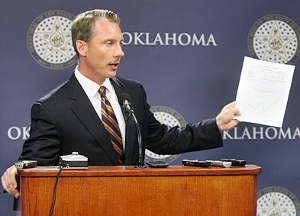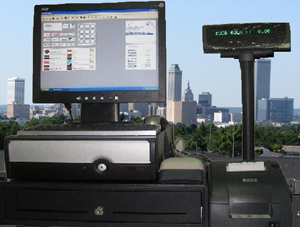
State Treasurer Ken Miller
Oklahoma Gross Receipts to the Treasury for Fiscal Year 2017 indicate the state’s treasury began recovery at the midpoint of the fiscal year and continued through June, lagging slightly behind state gross domestic product figures (GDP), State Treasurer Ken Miller said today during a State Capitol news conference.
Monthly gross receipts have been higher than the same month of the prior year for five of the past six months. FY-17 gross receipts remain lower than the prior fiscal year by 1.5 percent, but the rate of decline is much smaller than the 7.2 percent decline between FY-15 and FY-16.
June gross receipts, at $1 billion, are the highest June total since 2014. FY-17 gross receipts, at $11 billion, are the highest 12-month total in 10 months.
 The latest state GDP figures from the federal Bureau of Economic Analysis provide additional evidence of recovery. The most current figures, released in May, show Oklahoma’s economy expanded by 1.3 percent in fourth quarter of 2016 following four consecutive quarters of contraction.
The latest state GDP figures from the federal Bureau of Economic Analysis provide additional evidence of recovery. The most current figures, released in May, show Oklahoma’s economy expanded by 1.3 percent in fourth quarter of 2016 following four consecutive quarters of contraction.
With recessions typically defined as two or more consecutive quarters of GDP reduction, the state has emerged from a one-year recession.
“Current data is encouraging with lagging economic indicators showing improvement in the state economy,” Miller said. “Leading indicators also point to continued growth, but the anticipated strength of the recovery may be moderating as oil prices have come down slightly.”
June gross receipts are higher than those of June 2016 by $87 million, or 9.4 percent. All major revenue streams – income, gross production, sales and motor vehicle taxes – are above those of the prior year.
Collections from gross production taxes on crude oil and natural gas are higher than the prior year for a ninth consecutive month, generating $41.6 million, up by 63.5 percent.
FY-17 collections are down by $164.2 million, or 1.5 percent, compared to FY-16. Gross production receipts are up by more than 20 percent, while income, sales and motor vehicle tax receipts are down by rates ranging from 4.8 percent to 0.7 percent.
Other indicators
 Oklahoma’s seasonally-adjusted unemployment rate remained at 4.3 percent for a third consecutive month in May, according to the Oklahoma Employment Security Commission. State jobless numbers improved by seven-tenths of a percentage point over the year. The rate is equal to the national jobless rate for the same month.
Oklahoma’s seasonally-adjusted unemployment rate remained at 4.3 percent for a third consecutive month in May, according to the Oklahoma Employment Security Commission. State jobless numbers improved by seven-tenths of a percentage point over the year. The rate is equal to the national jobless rate for the same month.
The Oklahoma Business Conditions Index, predicting economic activity for the next three to six months, was set at 57.7 in June, up from 54.2 in May. It marks a sixth consecutive month above growth neutral following seven months of negative ratings. Numbers above 50 indicate anticipated economic expansion.
June collections
The report for June shows gross receipts at $1 billion, up $87 million, or 9.4 percent, from June 2016.
Gross income tax collections, a combination of individual and corporate income taxes, generated $371.7 million, an increase of $18.2 million, or 5.2 percent, from the previous June.
Individual income tax collections for the month are $302.3 million, up $16.9 million, or 5.9 percent, from the prior year. Corporate collections are $69.4 million, up by $1.3 million, or 2 percent.
Sales tax collections, including remittances on behalf of cities and counties, total $373.5 million in June. That is $22.4 million, or 6.4 percent above June 2016.
 Gross production taxes on oil and natural gas generated $41.6 million in June, an increase of $16.2 million, or 63.5 percent, from last June. Compared to May reports, gross production collections are up by $2.9 million, or 7.4 percent.
Gross production taxes on oil and natural gas generated $41.6 million in June, an increase of $16.2 million, or 63.5 percent, from last June. Compared to May reports, gross production collections are up by $2.9 million, or 7.4 percent.
Motor vehicle taxes produced $69.3 million, up by $3.5 million, or 5.3 percent, from the prior year.
Other collections, consisting of about 60 different sources including taxes on fuel, tobacco, horse race gambling and alcoholic beverages, produced $156.6 million during the month. That is $26.7 million, or 20.5 percent, more than last June.
Fiscal Year 2017 receipts
During Fiscal Year 2017, July 2016 through June 2017, gross revenue totals $11 billion. That is $164.2 million, or 1.5 percent, below collections for the previous fiscal year.
Gross income taxes generated $3.9 billion for the period, reflecting a drop of $198.6 million, or 4.8 percent, from Fiscal Year 2016, July 2015 to June 2016.
Individual income tax collections total $3.5 billion, down by $72.3 million, or 2 percent, from the prior fiscal year. Corporate collections are $400.7 million for the period, a decrease of $126.2 million, or 24 percent, from the previous period.
 Sales taxes for FY-17 generated $4.2 billion, a decrease of $68.7 million, or 1.6 percent, from FY-16.
Sales taxes for FY-17 generated $4.2 billion, a decrease of $68.7 million, or 1.6 percent, from FY-16.
Oil and gas gross production tax collections brought in $442.7 million during the fiscal year, up by $76.1 million, or 20.8 percent, from the previous period.
Motor vehicle collections total $753.6 million for the period. This is a decrease of $5.2 million, or 0.7 percent, from the trailing 12 months.
Other sources generated $1.6 billion, up $32.2 million, or 2 percent, from the previous 12 months.
About Gross Receipts to the Treasury
Since March 2011, the Treasurer’s Office has issued the monthly Gross Receipts to the Treasury report, which provides a timely and broad view of the state’s macro economy.
It is provided in conjunction with the General Revenue Fund allocation report from the Office of Management and Enterprise Services, which provides important information to state agencies for budgetary planning purposes.
The General Revenue Fund receives about half of the state’s gross receipts with the remainder paid in rebates and refunds, remitted to cities and counties, and placed into off-the-top earmarks to other state funds.
